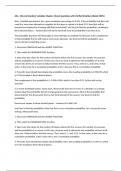Exam (elaborations)
Alta - Discrete Random Variables Chapter 4 Exam Questions with Verified Solutions (Rated 100%)
- Course
- Institution
Alta - Discrete Random Variables Chapter 4 Exam Questions with Verified Solutions (Rated 100%) Burt, a football quarterback, has a pass completion percentage of 55.2%. If the probability that Burt will need 8 or more pass attempts to complete his first pass in a game is at least 0.01, then Burt wi...
[Show more]



